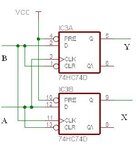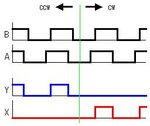mladens
Newbie level 3
Hi. I have an assignment at faculty to measure speed using incremental optical encoder (someone is using term rotary).
Have anyone done the similar project maybe? I get 2 analog signals and I use DA converter at begging. I have several questions, at the begging do I have to debounce the signals, or how to measure the frequency of signals (I guess I can't use interrupts). I am using MSP430 microcontroller
Thanks
Have anyone done the similar project maybe? I get 2 analog signals and I use DA converter at begging. I have several questions, at the begging do I have to debounce the signals, or how to measure the frequency of signals (I guess I can't use interrupts). I am using MSP430 microcontroller
Thanks

